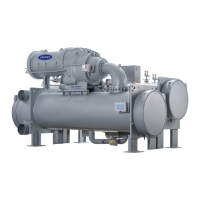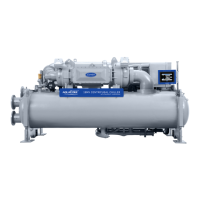15
SECONDARY OIL RECOVERY METHOD — The sec-
ondary method of oil recovery is significant under light load
conditions, when the refrigerant going up to the compressor
suction does not have enough velocity to bring oil along. Under
these conditions, oil collects in a greater concentration at the
top level of the refrigerant in the cooler. This oil and refrigerant
mixture is skimmed from the side of the cooler and is then
drawn up to the guide vane housing using discharge gas pres-
sure to power an eductor. There is a filter in this line. Because
the guide vane housing pressure is much lower than the cooler
pressure, the refrigerant boils off, leaving the oil behind to be
collected by the primary oil recovery method.
STARTING EQUIPMENT
The 19XR chiller requires a motor starter to operate the cen-
trifugal hermetic compressor motor, the oil pump, and various
auxiliary equipment. The starter is the main field wiring inter-
face for the contractor.
See Carrier Specification Z-415 for specific starter require-
ments, Z-416 for free-standing VFD requirements and Z-417
for unit-mounted VFD requirements. All starters must meet
these specifications in order to properly start and satisfy me-
chanical safety requirements. Starters may be supplied as sepa-
rate, free-standing units or may be mounted directly on the
chiller (unit mounted) for low voltage units only.
Typically three separate circuit breakers are inside the start-
er. This includes (1) the main compressor motor circuit breaker,
(2) a circuit breaker which provides power to chiller controls
and the oil heater (provided at 115 vac), and (3) a circuit break-
er which provides power at line voltage to the oil pump. The
latter two are typically wired in parallel with the first so that
power is provided to those services when the main breaker is
open. The disconnect switch on the starter front cover is con-
nected to the main breaker.
All starters and freestanding VFDs must include a Carrier
control module called the Integrated Starter Module (ISM), ex-
cluding the Benshaw solid-state and wye-delta MX3™ starters.
This module controls and monitors all aspects of the starter.
See the Controls section (following) for additional ISM infor-
mation. Contact Carrier’s Replacement Component Division
(RCD) for replacement parts.
Unit-Mounted Solid-State Starter (Optional) —
The 19XR chiller may be equipped with a solid-state, reduced-
voltage starter (Fig. 9 and 10). This starter’s primary function is
to provide on-off control of the compressor motor. This type of
starter reduces the peak starting torque, controls the motor in-
rush current, and decreases mechanical shock. This capability
is summed up by the phrase “soft starting.” The solid-state
starter is available as a 19XR option (factory supplied and in-
stalled). The solid-state starters manufacturer name is located
inside the starter access door.
A solid-state, reduced-voltage starter operates by reducing
the starting voltage. The starting torque of a motor at full volt-
age is typically 125% to 175% of the running torque. When the
voltage and the current are reduced at start-up, the starting
torque is reduced as well. The object is to reduce the starting
voltage to adjust the voltage necessary to develop the torque re-
quired to get the motor moving. The voltage is reduced by sili-
con controlled rectifiers (SCRs). The voltage and current are
then ramped up in a desired period of time. Once full voltage is
reached, a bypass contactor is energized to bypass the SCRs.
WARNING
The main circuit breaker on the front of the starter discon-
nects the main motor power only. Power is still energized
for two other circuits. Two additional circuit breakers
inside of the starter must be turned off to disconnect power
to the oil pump, PIC II controls and the oil heater. Failure to
disconnect power will result in personal injury.
MAIN CIRCUIT
BREAKER
TERMINAL
STRIP
MX
BOARD
METERS
SWITCHES
OPTIONAL
VOLT AND AMP
METERS AND
SELECTOR
SWITCHES
WIT
HE
Fig. 9 — Benshaw Solid-State Starter, Internal View
a19-1896

